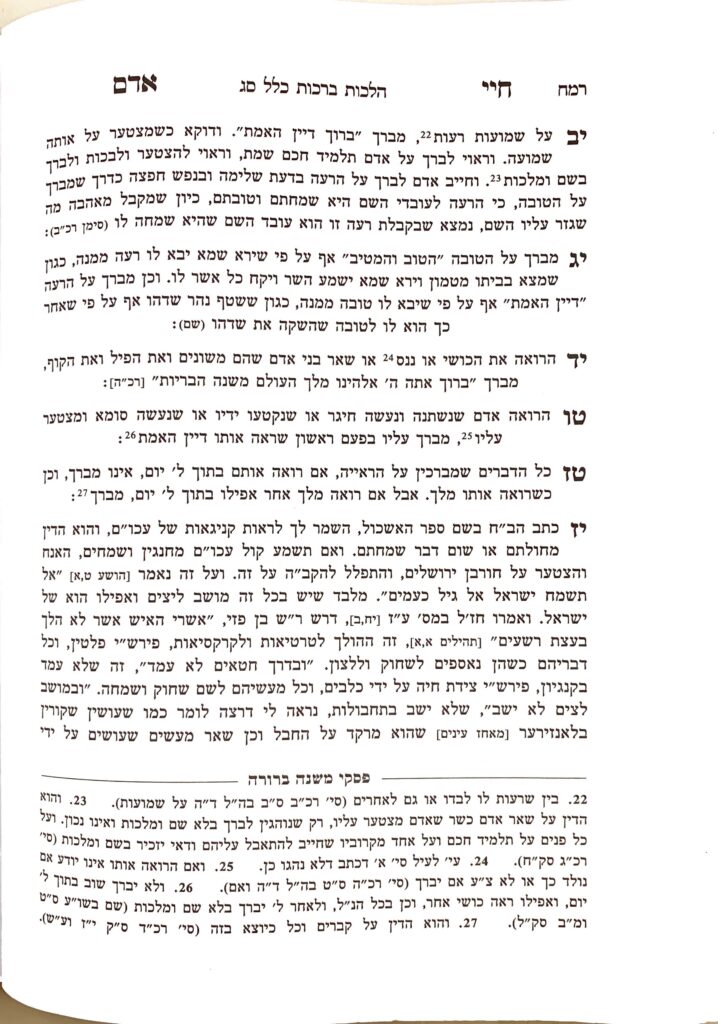We are beginning siman 14. When one sees a unique, striking individual, they recite the bracha of meshaneh habriyos. The Chayei Adam brings a midget, a giant, a person with extremely dark skin, and certain types of animals as examples of when this bracha is recited.
In siman 1, the Chayei Adam wrote regarding the bracha of shekacha lo b’olamo that we no longer make the bracha because we are used to seeing the striking individuals mentioned in siman 1, so we are no longer inspired in the way necessary to make the bracha (see shiur 1212). In that siman, he also mentioned that we no longer make this bracha of meshaneh habriyos for the same reason.
Some meforshim learn that this bracha is only made on a child born with dark skin from parents who are white skinned.
The bracha is also made on a monkey, elephant and a third animal, which is generally assumed to be an owl. The bracha is made on a monkey and owl because they have human elements and are strange in that regard. The bracha is made on the elephant due to its intelligence. The reasoning of the Chayei Adam to refrain from making the bracha nowadays would apply here as well. Therefore, one would not make the bracha with Hashem’s name. However, there are poskim who hold that one may still make the bracha on these animals, even though we no longer make the bracha on people.
Even if one were to make the bracha, there is a machlokes in the poskim whether one only makes the bracha the first time they see this animal (as was the halacha regarding shekacha lo beolamo, see shiur 1212), or every 30 days. Due to the safeik, Ashkenazim should not recite the bracha with Hashem’s name after their first sighting.
Rav David Yosef writes that one may recite the bracha with Hashem’s name after 30 days, and that appears to be the minhag of the Sephardim.
Kabbalistically, it is inappropriate to stare at a tamei item, so the argument could be made that it is inappropriate to look at a monkey, elephant or owl in order to make the bracha. Nevertheless, even kabbalistically, a person may glance quickly at the animal before making the bracha and still be in fulfillment of this kabbalistic concept.
In siman 15, the Chayei Adam writes that if one meets a friend who has undergone a significant physical change for the worse, such as losing a hand, becoming lame, or losing vision, they recite the bracha of dayan haemes. As we have learned previously (shiur 1228), the minhag is to refrain from making the bracha in these circumstances. Nevertheless, as we have learned, should one feel strongly about the situation, they may recite it.
Summary
- Ashkenazim recite the bracha of meshaneh habriyos upon their first sighting of a monkey, elephant and owl. After their first sighting, they recite the bracha without Hashem’s name. Sephardim can make the bracha with Hashem’s name every 30 days.
- The minhag for Sephardim and Ashkenazim is to refrain from making the bracha with Hashem’s name in all other circumstances.
- Even if one is careful not to stare at tamei items, they may glance quickly at these animals and still be in fulfilment of this kabbalistic concept.
- If one meets a friend who has undergone a significant physical change for the worse, our minhag is to refrain from reciting the bracha of dayan haemes. Nevertheless, since the original halacha is to recite it, should one feel strongly about the situation, they may recite it.



